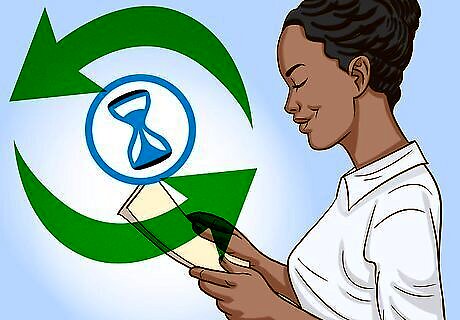
views
X
Research source
- A career portfolio allows you to showcase your achievements with work samples, awards, achievements, certifications, and references.
- Put your résumé at the front so that the interviewer may reference it and connect the pieces in your portfolio to your work experience.
- Include a table of contents if your portfolio is more than a few pages.
- Bring your portfolio with you to interviews in case they ask to see your work.
Populating Your Portfolio

Start with an up-to-date copy of your résumé. Your résumé is one of the most basic, and perhaps most important, documents in your portfolio. This document summarizes your education and experience and should always be in your portfolio, even if you've already submitted it separately to the potential employer. You may want to keep more than one copy of your résumé in your portfolio, in case a potential employer wants one.

Create lists of skills and qualifications. Think about all the things you can do and make a list. If you have skills in a variety of different areas, you may want to categorize them, or create separate skills pages so you can add or subtract as needed to make your portfolio relevant to the job for which you're interviewing. Include people skills, such as the ability to negotiate, lead, or communicate well. You can include references or examples in your portfolio to back these skills up. Feel free to include self-taught skills. In your portfolio, you have room to provide samples that show you know how to do something even if you don't have a formal certification for it.

Include proof of licenses, degrees, and certifications. scan or make copies of paper licenses and certificates to include in your portfolio. For degrees, you might include transcripts and highlight relevant courses. If you're including transcripts, scan it so you can make multiple copies. You may be applying for different jobs for which you would highlight different courses.

Get letters of recommendation. Letters of recommendation from people with knowledge of your skills and work ethic can persuade potential employers. If someone else had a good experience working with you, it gives a potential employer an idea of what they can expect. Former employers are good sources for recommendations, provided you left on good terms and had a good relationship with your boss or supervisor. Ask for letters of recommendation from someone who supervised you directly and observed your work. Professors or instructors are good sources for recommendations as well, particularly if they taught a course that is relevant to your career. For example, if you're looking for work as a web designer, you might get a recommendation from the instructor of your front-end development class. You also shouldn't overlook community leaders or political figures, provided they know you personally and have some experience working with you or observing your work ethic.

Collect samples of your work. Choose samples that are recent, showcase your skills, and generally make you look good. If you're just getting started, you may want to include samples from school projects rather than something you produced at work. You can create examples of your work just for your portfolio, but don't go overboard. Potential employers will be more impressed by something you created for a former employer or in a class, where you were under time constraints and your work was evaluated by a supervisor or instructor. With your work samples, include any feedback you got from them. For example, you might include the fact that you got an "A" on the project for a class, or that your supervisor recommended you for a promotion after you finished the project.

Highlight awards and accomplishments. Your portfolio is the place to let yourself shine, so you also want to include information about anything that you're proud of – even if it's not necessarily related to your career. Employers generally like having high achievers working for them. For example, if your rugby team won the state championship, by all means include that in your portfolio. Athletic honors and community leadership awards definitely have a place in your portfolio. Generally, leave out honors that are political or religious in nature, unless you're interviewing for a job with a political or religious organization where they would be relevant.
Organizing Your Portfolio

Look at the types of material you want to include. For most careers, most if not all of your portfolio contents will be standard, letter-sized paper. However, for some fields you may want to include over-size or digital media in your portfolio. Your portfolio can include anything portable. Larger documents can also be folded to fit in the confines of your binder. If you are in the technology field, you can create a CD of your work to include in your portfolio.

Buy a 3-ring binder or presentation binder and supplies. Physical portfolios typically look neatest in a 3-ring binder. Get a set of tabs to help organize the sections of your portfolio. You may need other inserts, depending on what you've decided to include. For example, if you have a career in tech and have included a CD, you can get CD holders that fit in 3-ring binders to easily secure your work. You can find the supplies you need online, at office supply stores, and even at discount stores. Generally, you'll find everything you need anywhere office or school supplies are sold.

Start with a title page and table of contents. Your title page should have basic information about you, including your name and contact information. Your table of contents sets out the sections of your portfolio and the types of documents included in each section, for quick reference. You can buy sets of tabs with a built-in table of contents page that coordinates the name of each section to the tab behind which that section falls.

Categorize your portfolio contents. Your categories may differ somewhat depending on your skills and career field. Generally, however, the easiest way to organize your portfolio is to think about how a typical job interview would go. For example, most interviewers start off the interview with a question along the lines of "Tell me a little about yourself." Make this question easy by making "About Me" the first section in your portfolio. Include your résumé, information about hobbies and interests, and personal skills such as languages you speak. You can also include reference letters in this section, or you can create another section for them. You may also have separate sections for education, employment, and leadership or community involvement.

Create tabs for each of your different sections. Inserts with tabs on the outside allow you to quickly jump to the section you need without having to thumb through the pages. They can also protect the pages in your portfolio from too much damage. Colored tabs with a table of contents typically don't have anything written on the tab itself. Instead, you'll use the table of contents to navigate through the sections. You may also have tabs with inserts where you would write the title of each section. If you use this type of tab, pick a set where you can type the names of the sections on a computer and feed the inserts through a printer. These sets have instructions for formatting your word processing app to print the tabs correctly.

Proofread all portfolio documents carefully. Before you put a document in your portfolio, check it several times to ensure it is free of grammar and spelling errors. You might also have someone else look over it to pick up anything you might have missed. Your portfolio should present your best image. A glaring error on any page of your portfolio sends the wrong message to potential employers, and all your hard work may backfire.
Using Your Portfolio

Bring your portfolio with you to interviews. At interviews, you can reference your portfolio when necessary. Look for opportunities to let the interviewer know that you have samples of your work and other material that they can look at. Be prepared to leave your portfolio behind if the interviewer wants some time to look it over after the interview. Don't bring your master or only one copy of your documents.

Customize your portfolio for each job opportunity. Your master portfolio includes everything you might ever want a potential employer to see. However, all of those documents won't necessarily be relevant to every opportunity you have. Add and remove documents as necessary to target particular employers and positions. Letters of recommendation are a good place to customize. For example, if you have a job interview scheduled and you know the interviewer is an alumni of your university, you might include letters from professors more prominently. When targeting work samples, include only samples of work similar to what you would probably be doing if you were hired by that company. For example, if you're interviewing for a job as a graphic designer, the interviewer likely won't be interested in the short story you wrote for your English class – even if it was published or won an award. It has nothing to do with your skills as a graphic designer.

Review your portfolio to assess your career development. Make it a habit to sit down with your master portfolio at least once a year. Look at each document, updating as necessary, and removing older work that has lost relevance. Looking back at your career in a nutshell like this can help you identify gaps in your training or areas where you might need continuing education to stay up-to-date with recent trends in the field. You may also notice the development of new skills that may open doors to new opportunities you wouldn't have considered before.

Create a digital backup of your master portfolio. Once you've gone to all that work, you don't want to lose it. If you have a digital backup of all the documents in your portfolio, you can easily update it or recreate it if anything happens to your physical copy. You might also consider putting your portfolio on a website. You can include a link to the website on your résumé. This could be especially helpful if you're in tech or media.



















Comments
0 comment